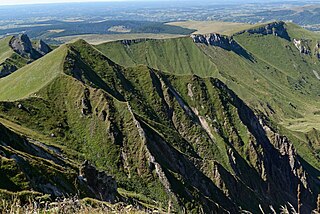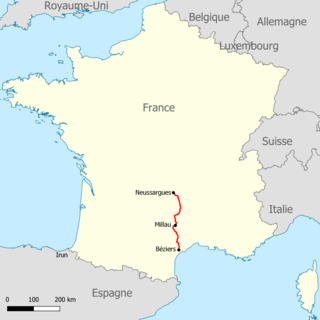
The Massif Central is a highland region in south-central France consisting of mountains and plateaus. It covers about 15% of mainland France.

The Millau Viaduct is a multispan cable-stayed bridge completed in 2004 across the gorge valley of the Tarn near Millau in the Aveyron department in the Occitanie Region, in Southern France. The design team was led by engineer Michel Virlogeux and English architect Norman Foster. As of October 2023, it is the tallest bridge in the world, having a structural height of 343 metres (1,125 ft).

The Tarn is a 380.2-kilometre (236.2 mi) long river in the administrative region of Occitania in southern France. It is a right tributary of the Garonne.

The A75 is an autoroute (motorway) in France.

The Cirque de Navacelles is large erosional landform, an incised meander, located towards the southern edge of the Massif Central mountain range in France. It is located near Saint-Maurice-Navacelles and Blandas between the Hérault department and the Gard department.

The Route nationale 7, or RN 7, is a trunk road (nationale) in France between Paris and the border with Italy. It was also known as Route des vacances, Route bleue, and — sarcastically, during the annual rush to the Mediterranean beaches — the Route de la mort.
The Route nationale 3 is a trunk road (nationale) in France connecting Paris to the frontier of Germany.
The Route nationale 1 is a trunk road (nationale) in France between Paris and Calais. It is approximately 339 km (211 mi) long.
The Route nationale 6 is a trunk road (nationale) in France between Paris and the frontier with Italy in the Alps.
The Route nationale 8, or RN 8, was a trunk road (nationale) in southeast France between Aix-en-Provence and Toulon.

Route nationale 10, or RN 10, is a trunk in France between Paris and the border with Spain via Bordeaux.
The Route nationale 16, or RN16, is a trunk road (nationale) in France crossing Picardy north of Paris.
The Route nationale 17, or RN17, is a trunk road (nationale) in France connecting Paris to the border with Belgium.

The Route nationale 19 (N19) is a trunk road (nationale) in north east France. The road forms part of European route E54.

The Route nationale 20 (N20) is a trunk road (nationale) between Paris and the frontier with Spain heading south through the heart of France and passing through the Cathedral City of Orléans and Toulouse. The road forks at Col de Puymorens with one branch being the Route nationale 22 which leads to Andorra. In winter, avalanches sometimes close the road.

The A9 autoroute is a motorway in Southern France.

The A71 autoroute is a motorway in central France. It is also called l'Arverne. It starts at Orléans and ends at Clermont-Ferrand.
The Route nationale 23 (N23) is a trunk road (nationale) in western France.
Terrasses du Larzac is an Appellation d’origine contrôlée (AOC) within the Côteaux du Languedoc in Southern France created in 2005 for red wines made from Syrah, Grenache and Mourvèdre grapes, with the acceptable additions of Cinsaut and Carignan, and grown in some of the highest vineyards of the Côteaux du Languedoc on the slopes of the Cevennes.

The Béziers to Neussargues Railway, also known as the Causses Railway, is a French rail transport connecting Béziers, near the Languedoc coast, to Neussargues in the department of Cantal, crossing the Millau and the Causses plateaus.













